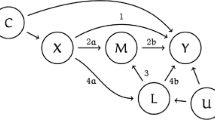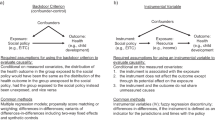Abstract
The assumption that exposures as measured in observational settings have clear and specific definitions underpins epidemiologic research and allows us to use observational data to predict outcomes in interventions. This leap between exposures as measured and exposures as intervened upon is typically supported by the consistency assumption. The consistency assumption has received extensive attention in risk factor epidemiology but relatively little emphasis in social epidemiology. However, violations of the consistency assumption may be especially important to consider when understanding how social and economic exposures influence health. Efforts to clarify the definitions of our exposures, thus bolstering the consistency assumption, will help guide interventions to improve population health and reduce health disparities. This article focuses on the consistency assumption as considered within social epidemiology. We explain how this assumption is articulated in the causal inference literature and give examples of how it might be violated for three common exposures in social epidemiology research: income, education, and neighborhood characteristics. We conclude that there is good reason to worry about consistency assumption violations in much of social epidemiology research. Theoretically motivated explorations of mechanisms along with empirical comparisons of research findings under alternative operationalizations of exposure can help identify consistency violations. We recommend that future social epidemiology studies be more explicit to name and discuss the consistency assumption when describing the exposure of interest, including reconciling disparate results in the literature.


Similar content being viewed by others
References
Papers of particular interest, published recently, have been highlighted as: • Of importance •• Of major importance
Stein G, Sacred Emily. Geography and plays. Boston: The Four Seas Company; 1922, p. 178.
Robins JM, Hernan MA, Brumback B. Marginal structural models and causal inference in epidemiology. Epidemiology. 2000;11(5):550–60.
Stuart EA. Matching methods for causal inference: a review and a look forward. Stat Sci: Rev J Inst Math Stat. 2010;25(1):1.
Hill AB. The environment and disease: association or causation? Proc R Soc Med. 1965;58:295–300.
Rothman K, Greenland S. Causation and causal inference in epidemiology. Am J Public Health. 2005;95(S1):S144–50.
Kiefer J, Wolfowitz J. Consistency of the maximum likelihood estimator in the presence of infinitely many incidental parameters. Ann Math Stat. 1956:887-906.
Gibbard A, Harper WL. Counterfactuals and two kinds of expected utility: Springer Netherlands ; 1981, pp 153-190. [A fundamental development of counterfactual theory which describes the requirement of consistency for inference.]
Pearl J. On the consistency rule in causal inference: axiom, definition, assumption, or theorem? Epidemiology. 2010;21(6):872–5.
Braveman PA, Cubbin C, Egerter S, Chideya S, Marchi KS, Metzler M, et al. Socioeconomic status in health research: one size does not fit all. JAMA. 2005;294(22):2879–88. doi:10.1001/jama.294.22.2879.
Adler NE, Rehkopf DH. US disparities in health: descriptions, causes, and mechanisms. Annu Rev Public Health. 2008;29:235–52.
Hernán MA, VanderWeele TJ. Compound treatments and transportability of causal inference. Epidemiology (Cambridge, Mass). 2011;22(3).
Duncan GJ, Magnuson KA. Off with Hollingshead: Socioeconomic resources, parenting, and child development. Socioeconomic status, parenting, and child development. 2003:83-106.
Kaufman JS, Cooper RS. Seeking causal explanations in social epidemiology. Am J Epidemiol. 1999;150(2):113–20.
Hernán M, Taubman S. Does obesity shorten life? The importance of well-defined interventions to answer causal questions. International Journal of Obesity. 2008;32:S8–S14. This article gives an overview of the importance of the consistency assumption for causal inference in epidemiology illustrated using the example of studies of the effects of obesity on mortality.
Cole SR, Frangakis CE. The consistency statement in causal inference: a definition or an assumption? Epidemiology. 2009;20(1):3–5. A summary of the importance of the consistency assumption.
VanderWeele TJ. Concerning the consistency assumption in causal inference. Epidemiology. 2009;20(6):880–3. This article clarifies the basis of the consistency assumption and provides details about the range of treatments.
Bareinboim E, Pearl J. A general algorithm for deciding transportability of experimental results. J Causal Inference. 2013;1(1):107–34.
Kawachi I, Adler NE, Dow WH. Money, schooling, and health: mechanisms and causal evidence. Ann N Y Acad Sci. 2010;1186(1):56–68.
Benzeval M, Judge K. Income and health: the time dimension. Soc Sci Med. 2001;52(9):1371–90.
Catalano R, McConnell W. Psychiatric emergencies: the check effect revisited. J Health Soc Behav. 1999;79–86.
Rehkopf DH, Strully KW, Dow WH. The short-term impacts of Earned Income Tax Credit disbursement on health. Int J Epidemiol. 2014:dyu172.
Wolfe B, Jakubowski J, Haveman R, Courey M. The income and health effects of tribal casino gaming on American Indians. Demography. 2012;49(2):499–524.
Fernald LC, Gertler PJ, Neufeld LM. Role of cash in conditional cash transfer programmes for child health, growth, and development: an analysis of Mexico’s Oportunidades. Lancet. 2008;371(9615):828–37.
Smith JP. Healthy bodies and thick wallets: the dual relation between health and economic status. J Econ Perspect: J Am Econ Assoc. 1999;13(2):144.
Gardner J, Oswald AJ. Money and mental wellbeing: a longitudinal study of medium-sized lottery wins. J Health Econ. 2007;26(1):49–60.
Apouey B, Clark AE. Winning big but feeling no better? The effect of lottery prizes on physical and mental health. Health Econ. 2015;24(5):516–38.
Evans WN, Moore TJ. The short-term mortality consequences of income receipt. J Public Econ. 2011;95(11):1410–24.
Romich JL, Weisner T. How families view and use the EITC: advance payment versus lump sum delivery. Nat Tax J. 2000:1245-65.
Cohen AK, Syme SL. Education: a missed opportunity for public health intervention. Am J Public Health. 2013;103(6):997–1001.
Glymour MM, Manly JJ. Lifecourse social conditions and racial and ethnic patterns of cognitive aging. Neuropsychol Rev. 2008;18(3):223–54. doi:10.1007/s11065-008-9064-z.
Manly JJ, Schupf N, Tang MX, Stern Y. Cognitive decline and literacy among ethnically diverse elders. J Geriatr Psychiatry Neurol. 2005;18(4):213.
Liu SY, Glymour MM, Zahodne LB, Weiss C, Manly JJ. Role of place in explaining racial heterogeneity in cognitive outcomes among older adults. J Int Neuropsychol Soc. 2015;21(09):677–87. doi:10.1017/S1355617715000806.
Nguyen T, Tchetgen Tchetgen E, Kawachi I, Gilman SE, Walter S, Glymour MM. Comparing alternative effect decompostion methods: the role of literacy in mediating educational effects on mortality. Epidemiology. 2015.
Nye B, Hedges LV, Konstantopoulos S. The long-term effects of small classes: a five-year follow-up of the Tennessee class size experiment. Educ Eval Policy Anal. 1999;21(2):127–42.
Chetty R, Friedman JN, Hilger N, Saez E, Schanzenbach DW, Yagan D. How does your kindergarten classroom affect your earnings? Evidence from Project STAR. Nat Bur Econ Res 2011;126(4):1593–660.
Lleras-Muney A. The relationship between education and adult mortality in the United States. Rev Econ Stud. 2005;72(1):189–221.
Silles MA. The causal effect of education on health: evidence from the United Kingdom. Econ Educ Rev. 2009;28(1):122–8.
Glymour MM, Kawachi I, Jencks CS, Berkman LF. Does childhood schooling affect old age memory or mental status? Using state schooling laws as natural experiments. J Epidemiol Community Health. 2008;62(6):532–7. doi:10.1136/jech.2006.059469.
Nguyen T, Tchetgen Tchetgen E, Kawachi I, Gilman SE, Walter S, Liu S, Manly J, Glymour M. Instrumental variable approaches to identifying the causal effect of educational attainment on dementia risk. Ann Epidemiol. 2016;26(1):71–76.e3. doi:10.1016/j.annepidem.2015.10.006.
Campbell F, Conti G, Heckman JJ, Moon SH, Pinto R, Pungello E, et al. Early childhood investments substantially boost adult health. Science. 2014;343(6178):1478–85.
Conti G, Heckman JJ, Pinto R. The effects of two influential early childhood interventions on health and healthy behaviors. Nat Bur Econ Res. 2015.
Sampson RJ, Raudenbush SW, Earls F. Neighborhoods and violent crime: a multilevel study of collective efficacy. Science. 1997;277(5328):918–24.
Katz B. Neighbourhoods of choice and connection: The evolution of American neighbourhood policy and what it means for the United Kingdom: Joseph Rowntree Foundation; 2004.
Osypuk TL, Tchetgen Tchetgen EJ, Acevedo-Garcia D, Earls FJ, Lincoln A, Schmidt NM, et al. Differential mental health effects of neighborhood relocation among youth in vulnerable families: results from a randomized trial. Arch Gen Psychiatry. 2012;69(12):1284–94.
Kling JR, Liebman JB, Katz LF. Experimental analysis of neighborhood effects. Econometrica. 2007;75(1):83–119.
Lindberg RA, Shenassa ED, Acevedo-Garcia D, Popkin SJ, Villaveces A, Morley RL. Housing interventions at the neighborhood level and health: a review of the evidence. J Public Health Manag Pract. 2010;16(5):S44–52.
Osypuk TL, Joshi P, Geronimo K, Acevedo-Garcia D. Do social and economic policies influence health? A review. Curr Epidemiol Rep. 2014;1(3):149–64.
Emerson RW, John Davis Batchelder Collection (Library of Congress). Essays. Boston; J. Munroe and Company; 1841. 303 p. p.
Vandenbroucke JP, Broadbent A, Pearce N. Causality and causal inference in epidemiology—the need for a pluralistic approach. Int J Epidemiol. 2016;dvy341.
Concato J, Shah N, Horwitz RI. Randomized, controlled trials, observational studies, and the hierarchy of research designs. N Engl J Med. 2000;342(25):1887–92.
Druesne‐Pecollo N, Latino‐Martel P, Norat T, Barrandon E, Bertrais S, Galan P, et al. Beta‐carotene supplementation and cancer risk: a systematic review and metaanalysis of randomized controlled trials. Int J Cancer. 2010;127(1):172–84.
Van Poppel G. Epidemiological evidence for beta-carotene in prevention of cancer and cardiovascular disease. Eur J Clin Nutr. 1996;50:S57–61.
Peto R, Doll R, Buckley JD, Sporn M. Can dietary beta-carotene materially reduce human cancer rates? 1981;290(5803):201–208
Nandi A, Harper S. How consequential is social epidemiology? A review of recent evidence. Curr Epidemiol Rep. 2014;2(1):61–70.
Galea S. An argument for a consequentialist epidemiology. Am J Epidemiol. 2013;178(8):1185–1191. doi:10.1093/aje/kwt172.
Collins J, Koplan JP. Health impact assessment: a step toward health in all policies. JAMA. 2009;302(3):315–7.
Marmot MG, Allen J. From science to policy. In: Berkman LF, Kawachi I, Glymour M, editors. Social epidemiology. 2nd ed. New York: Oxford University Press; 2014.
Author information
Authors and Affiliations
Corresponding author
Ethics declarations
Conflict of Interest
David H. Rehkopf, M. Maria Glymour, and Theresa L. Osypuk declare that they have no conflict of interest.
Human and Animal Rights and Informed Consent
This article does not contain any studies with human or animal subjects performed by any of the authors.
Funding
David H. Rehkopf was supported by the National Institute on Aging of the National Institutes of Health under award number K01AG047280. The content is solely the responsibility of the authors and does not necessarily represent the official views of the National Institutes of Health.
Additional information
This article is part of the Topical Collection on Social Epidemiology
Rights and permissions
About this article
Cite this article
Rehkopf, D.H., Glymour, M.M. & Osypuk, T.L. The Consistency Assumption for Causal Inference in Social Epidemiology: When a Rose Is Not a Rose. Curr Epidemiol Rep 3, 63–71 (2016). https://doi.org/10.1007/s40471-016-0069-5
Published:
Issue Date:
DOI: https://doi.org/10.1007/s40471-016-0069-5




